People of the collection history
Abel, Herbert
Herbert Abel published the book “Vom Raritätenkabinett zum Bremer Überseemuseum. Die Geschichte einer hanseatischen Sammlung aus Übersee” (“From the cabinet of rarities to the Überseemuseum of Bremen. The history of a hanseatic collections from oversea”, Bremen, Röver, 352 pages), since the museum celebrated its 75th birthday in 1970.
Borcherding, Friedrich
He was born in Groß-Minmelage near Quakenbrück and became a school-teacher in Bremen-Vegesack in 1872. Friedrich Borcherding worked on the molluscan fauna of northwestern Germany and published several dozen papers on this topic. Since 1895 he joined the Städtisches Museum für Natur-, Völker- und Handelskunde (Museum for natural history, ethnology and trading of the city) and focused on terrestrial snails from Hawai, USA.
Böttner, Louis
He was quarry owner in eastern Germany. In 1913 trackways of reptiles as well as bones and ripple marks were purchased.
Brandt, Otto
Otto Brandt originated from Vlotho and collected in the Upper Triassic (German Keuper), Jurassic and in the Upper Cretaceous. Only in 1865 more than 191 specimens from the Campanian of the Stemwede hill came into the collection as a result of activity.
von dem Busch, Dr. Gerhard
Dr. von dem Busch was a medical doctor. He was born in 1791 and studied medicine and natural history from 1811 in Göttingen, where he got his PhD in 1814. Since 1815 he was general practitioner in a poor peoples area within Bremen-Walle. He collected bivalves and gastropods and build up contacts with the conchyologists of that time, like Pfeiffer and Philippi in Kassel, Dunker in Marburg, Prätorius in Vienna and Lea in Philadelphia. The largest part of his collection inclusively the associated catalogues are reserved.
Eylmann, Dr. Erhard
Dr. Eylmann went to Australia between 1896 and 1912 and collected fossils and recent molluscs that he donated to the museum back in Bremen. He is well-known for his research on Australia. Eylmann comes from Krautsand at the river Elbe, and lived in Cairo, Hamburg, Bremen-Farge, and Bremen-Blumenthal.
Finsch, Dr. Otto
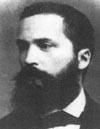 Dr. Finsch was conservator since 1864 and in 1874 became head of the Gesellschaft Museum (Association Museum) and director of the museum of the city of Bremen. Colonel Niebour donated an ichthyosaur from the Posidonia shale of the Lower Jurassic of Bad Boll, Swabian Alb in southern Germany, to him. In 1878 he travelled through western Siberia and collected minerals and rock samples for the collection. He also donated the ground and polished rock samples from the Kolywan manufacturer, northwest of Altai.
Dr. Finsch was conservator since 1864 and in 1874 became head of the Gesellschaft Museum (Association Museum) and director of the museum of the city of Bremen. Colonel Niebour donated an ichthyosaur from the Posidonia shale of the Lower Jurassic of Bad Boll, Swabian Alb in southern Germany, to him. In 1878 he travelled through western Siberia and collected minerals and rock samples for the collection. He also donated the ground and polished rock samples from the Kolywan manufacturer, northwest of Altai.
Förstner
Förstner is a member on an old trader’s family in the Hanseatic city of Bremen, however, his biography is unclear. He collected in the Alpine region and in Bavaria, particularly remarkable are his palaeontological collections from the Alpine Triassic of St. Cassian. His collection was donated to the museum in about 1890.
Von Giesecke, Karl Ludwig
Karl Ludwig von Giesecke was born in Augsburg in 1761. He was studying law in Vienna, but his main interest was mineralogy. After he got a nomination as a Prussian adviser for geology (Bergrat) he travelled to the Faroe Islands and to the westcoast of Greenland between 1806 and 1813. After the last trip he became a professor of mineralogy. The catalogue of his collection, with a full account of the fossils and minerals of the Bremen collections, is dated 1802.
Von Gwinner, Arthur
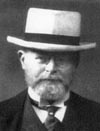 Arthur von Gwinner was born in Frankfurt in 1856. He took a commercial apprenticeship in a bank (Mitteldeutsche Kreditbank) in his home town, between 1876 and 1885 he worked in London and Madrid. Von Gwinner moved to Berlin in 1887 were he founded his own bank and became head of the Deutsche Bank in 1893. He collected minerals, mainly by purchasing specimens. In 1997 his collection was celebratory given to the university as a permanent loan by his grandson Dr. Wolfgang Klingler.
Arthur von Gwinner was born in Frankfurt in 1856. He took a commercial apprenticeship in a bank (Mitteldeutsche Kreditbank) in his home town, between 1876 and 1885 he worked in London and Madrid. Von Gwinner moved to Berlin in 1887 were he founded his own bank and became head of the Deutsche Bank in 1893. He collected minerals, mainly by purchasing specimens. In 1997 his collection was celebratory given to the university as a permanent loan by his grandson Dr. Wolfgang Klingler.
Hartman, William Dell
William Dell Hartman was a private collector in West Chester in the US state of Pennsylvania. He collected marine molluscs as well as freshwater and terrestrial snails. His collection comprises of more than 10000 specimens.
Prof. Dr. Richard Rud. Gustav
Prof. Hermann was born in 1840 in Neudorf near Stolzenau and died in Bremen-Vegesack in 1915. From 1870 he was a teacher/teacher at the Realgymnasium in Vegesack (today Gerhard Rohlfs-Schule). Hermann had immigrated from Poznan in 1870, where his parents had moved to. He was married twice and has lived at different addresses over the years. After his death several fossils were purchased by the Überseemuseum from his widow after his death (February 1, 1916), including remains of cave bears from the Bärenhöhle near Erpfingen/Swabian Alb.
Hülsenbeck-Hoyermann, Dr. Thekla
Dr. Thekla Hülsenbeck-Hoyermann studied palaeontology in Göttingen. She worked together with August Jordan in the Geological Collection and between 1933 and 1944 she took over the full responsibility for the collection.
Jordan, August
August Jordan was born in Almstedt near Brunswick. He moved to Bremen in 1875, but did not work in the Städtisches Museum für Natur-, Völker- und Handelskunde (Museum for natural history, ethnology and trading of the city) before 1894. August Jordan collected in the Mesozoic of the northern rim of the Harz mountains and in the Tertiary of the classical localities Doberg and Brandhorst as well as in the Teutoburger Wald area. Although he did not get an academic education he published about the Miocene of Hassendorf near Rotenburg at the river Wümme.
von Klipstein, Professor August
Professor von Klipstein was born in 1801 and studied geology and mineralogy. He originated from Hohensolm in Hessen and was head of a mining company between 1831 and 1865, thereafter he became a professor at Gießen University. His comprehensive collection from the Triassic of St. Cassian was the base for an intensive scientific debate between 1842 and 1845, including discussions with the famous palaeontologist Hans Bruno Geinitz in Saxony. A part of his collection was probably acquired for Bremen by van dem Busch, other parts are housed in museums in Darmstadt, London, Vienna and Budapest.
Knipper, Dr. Helmut
Dr. Helmut Knipper, born in 1914, was curator for the recent molluscs of the Übersee-Museum in the middle of the 1950s. In 1956 he went to the Natural History Museum in Karlsruhe. He died in 1974, and more than 30 years after his death a collection of specimens was discovered that he had relocated from Bremen to Karlsruhe.
von Knoop, Baron Ludwig
Baron von Knoop was born in Bremen in 1821 as the son of a tobacco trader. He moved to Russia and was making his living from owning a spinning mill, however, he did not lose contact with his hometown Bremen. He arranged the donation of a large collection of fossils owned by the Russian prince Wittgenstein between the years 1860 and 1890 that is a part of the collection in recent days.
Krause, Aurel
In 1889 Aurel Krause collected molluscs from Sicily, Tenerife and the Canary Islands. Joined by his brother Arthur he travelled to the northwest of North America in 1821/1822, instructed by the Bremen Geographical Society. The brothers collected fossils from the Quaternary of the Lawrence Bay for the city of Bremen. In 1885 they published a summary of this journey entitled “Results of a journey to the northwest coast of America and the Bering strait” (translated from German) in Jena, eastern Germany.
Kruckow, Dr. Thorwald
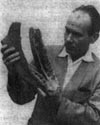 Dr. Thorwald Kruckow was born in 1919. He studied in Berlin were he also got his PhD. He changed to the Übersee-Museum in Bremen in 1953 and was curator for geology between 1953 and 1981. During the first years at Bremen his main goal was to rearrange the collections that were damage by the war. Later he travelled to Mexico and collected for example a rich collection of sharks teeth. He published several papers about this material and added data of shark material from Florida and northern Germany. During a second journey to Costa Rica he collected Tertiary rocks from classical localities. Thorwald Kruckow was also very active in motivating amateurs to deal with geology and palaeontology. He educated Herbert Menzel, who later became a frequently requested specialist for tertiary otolithes.
Dr. Thorwald Kruckow was born in 1919. He studied in Berlin were he also got his PhD. He changed to the Übersee-Museum in Bremen in 1953 and was curator for geology between 1953 and 1981. During the first years at Bremen his main goal was to rearrange the collections that were damage by the war. Later he travelled to Mexico and collected for example a rich collection of sharks teeth. He published several papers about this material and added data of shark material from Florida and northern Germany. During a second journey to Costa Rica he collected Tertiary rocks from classical localities. Thorwald Kruckow was also very active in motivating amateurs to deal with geology and palaeontology. He educated Herbert Menzel, who later became a frequently requested specialist for tertiary otolithes.
Kükenthal, Willy
Willy Kükenthal was a member of the Greenland expedition of the city of Bremen in 1897. He collected recent molluscs and other material during this journey.
Kuster-Wendenburg, Dr. Elisabeth
Ludwig, Hubert
Dr. Hubert Ludwig was born in Hamburg in 1852. He studied zoology and after working as an unsalaried lecturer in Göttingen he took over the responsibility for the Städtischen Sammlungen für Naturgeschichte und Ethnographie (Collections for natural history and ethnography of the city) in Bremen in 1878. There was only a small number of people working with him in the museum, all of them were non-educated assistants. Within two and a half years after he became the head of the museum he moved to Gießen to gain a professorship in the spring of 1881.
Martens, E.
E. Martens was a citizen of Berlin. He worked with the agate snails of the collection and donated some type material (gastropods from South America) by exchange (after 1884).
Menzel, Herbert
Herbert Menzel from Bremen was born in 1927 and worked until his retirement in 1990 as technical staff in a textile factory. Back in 1968 he started to work on microfossils and in particular otolithes, encouraged by Dr. Thorwald Kruckow. He joined the VfMG (an amateur society for geology in Germany) in 1976 and consequently he published most of his papers in the associated journal, the “Aufschluss”. This led to him being honoured with the Wilke award of the society in 1997 and 2000, a prize honouring exclusively amateurs that are publishing in the field of geology. He received the research award of the Naturwissenschaftlicher Verein Bremen (Natural History Society of Bremen) in 1976 and 1980 for his papers on fossil otolithes and became an honorary member in 1999. His close relation to the Übersee-Museum and since the middle of the 1990s to the university lead to the decision to donate his collection to the Geosciences Collection. His unique collection was transferred in excellent condition, well labelled and already completely accessible in an IT data base.
Meyer, Alfons P.
Alfons P. Meyer collected erratic boulders in Berlin. His collection was purchased in 1955, however, he was active in the field of glacial geology for a long period of time after that, as his papers on erratic boulders in the journal “The Erratic Boulder Collector” (“Der Geschiebesammler”) published between the end of the 1960s and the 1970s demonstrate.
Schauinsland, Prof. Dr. Hugo
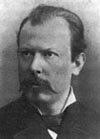 Prof. Hugo Schauinsland was born in eastern Prussia (nowadays Russia) and studied Natural History. He finished his PhD in zoology in 1883 and became assistant lecturer at the University of Königsberg (now Kaliningrad in Russia) and Munich. Prof. Schauinsland was head of the Museum für Natur-, Völker- und Handelskunde (Museum for natural history, ethnology and trading of the city) between 1896 and 1933.
Prof. Hugo Schauinsland was born in eastern Prussia (nowadays Russia) and studied Natural History. He finished his PhD in zoology in 1883 and became assistant lecturer at the University of Königsberg (now Kaliningrad in Russia) and Munich. Prof. Schauinsland was head of the Museum für Natur-, Völker- und Handelskunde (Museum for natural history, ethnology and trading of the city) between 1896 and 1933.
Schmacker, Philipp Bernhard
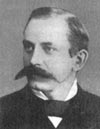 Philipp Bernhard Schmacker was born in 1852. He focussed on natural history, however, since he was a member of a trader’s family he was sent to Hongkong when he was only 20 years old. He worked in Kanton and Shanghai, but he collected recent molluscs in China and other regions of eastern Asia. Schmacker left his complete mollusc collection and additional 197 Goldtaler to the city of Bremen.
Philipp Bernhard Schmacker was born in 1852. He focussed on natural history, however, since he was a member of a trader’s family he was sent to Hongkong when he was only 20 years old. He worked in Kanton and Shanghai, but he collected recent molluscs in China and other regions of eastern Asia. Schmacker left his complete mollusc collection and additional 197 Goldtaler to the city of Bremen.
Spengel, J. W.
Dr J. W. Spengel was a zoologist and was born in 1852 in Trier. After Dr. Hubert Ludwig left the museum he took over the leadership between 1881 and 1886 of the Städtischen Sammlungen für Naturgeschichte und Ethnographie in Bremen (Museum for natural history, ethnography of the city). He made a comprehensive revision of specimens in the field of natural history, in particular he took care of the collection of modern bivalves.
von Struve, Heinrich Christoph Gottfried
Heinrich Christoph Gottfried von Struve was born about 1760. He studied political science in Erlangen and became a civil servant in Russia. In 1796 he moved to Hamburg where he worked as a secretary as he did later in other Hanseatic cities. Von Struve was an amateur mineralogist and possessor of a large collection that was purchased by the Naturwissenschaftlicher Verein in 1820. In 1920 the chemist Georg Ludwig Ulex named the mineral Struvit to honour von Struve.
Wendt, Johann Wilhelm
Captain Johann Wilhelm Wendt was born in 1802 as the son of an old sailors family. He made several global journeys by sailing-boat where he collected sea-shells extensively. Even the famous natural scientist Alexander von Humboldt benefited from his material in 1884. A comprehensive biography about him was published by Dr. Kuster-Wendenburg 2002 (“Entdeckungsfahrten im Auftrag Preussens. Der Bremer Kapitän Wendt 1802 bis 1847”, Aschenbeck & Holstein, Delmenhorst).
